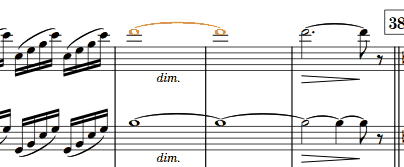Dear snakeeyes,
I believe you are mistaken on the point of when a tie is invoked, provided you select all notes before invoking the tie. If you want the tenor to look like the baritone in your example (whole note tied to whole note tied to dotted half tied to eighth note),
You can do the following:
Press enter to activate note entry mode.
Type the letter O (to engage force duration mode).
Type 8 G
Type G
Type 7.G
Type 5 G
Press escape key (to get out of note entry mode).
Select all notes desired to be tied.
Press T
I swear this works (at least it does for me).
Alternatively, you could follow the above directions, but type “T” after each note entry to tie as you go (leaving off the last 2 instructions).
I’m not sure why one would tie notes together in stages (several actions) when you can simply select all and hit “T”. If you tie notes together in several stages, the first notes you tie together become “one note”, (at that very moment), separate from the tie chain, and so on.
(Perhaps I am misunderstanding your desired end result). Please try to do exactly what I showed you and it should work!
I do agree with you that if you tie notes together in stages and then try to get one tie of the intermediary groups, you may get unwanted results. That’s why I suggest you select all notes to be tied together and hit “T” to do the trick in one keystroke, which is easier anyway. 
If you desire to not re-input all of the notes, the quickest way to fix the notation of the tenor as you show (with the double dotted half that you don’t want) is:
Select the tied note
Press the letter U (to cut with the scissors tool)
Select the last note
Type the letter O (force duration on)
Type 7. (7 then period key to get dotted half forced duration)
Press the right arrow
Press the enter key (to get into note entry mode)
Type 5G
Press the escape key
Select all the notes you desire to be tied
Press T
It works like a charm because all notes are selected before tying.
I hope this helps!

